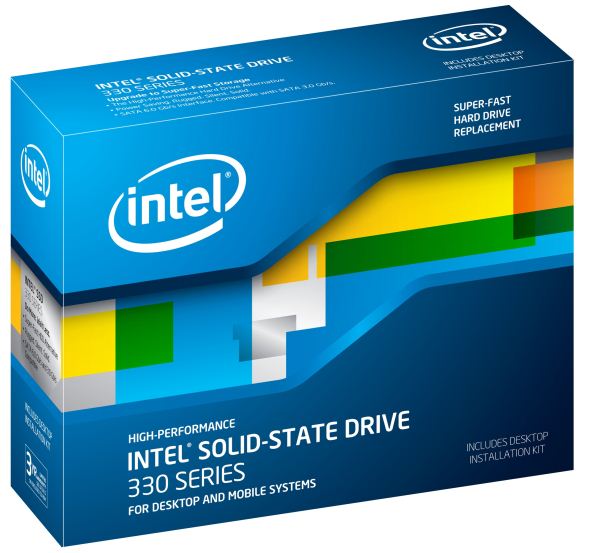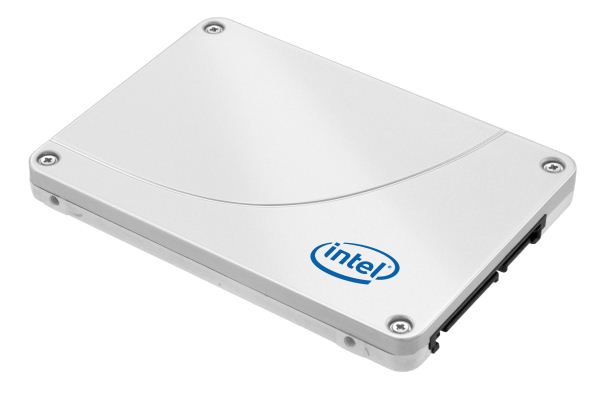Intel SSD 330 Officially Announced: Affordable SandForce
by Anand Lal Shimpi on April 16, 2012 11:00 AM ESTWe reported on Intel's SSD 330 weeks ago, but today is the official announcement of the drive and its availability in the channel. Unlike previous 300 series drives, the 330 isn't based on Intel's own controller - it's the second SandForce SF-2281 drive in Intel's lineup.
| Intel SSD Comparison | ||||||
| Intel SSD 520 | Intel SSD 510 | Intel SSD 330 | Intel SSD 320 | |||
| Capacity | 60 / 120 / 180 / 240 / 480GB | 120 / 250GB | 60 / 120 / 180GB | 40 / 80 / 120 / 160 / 300 / 600GB | ||
| Controller | SandForce SF-2281 | Marvell 9174 | SandForce SF-2281 | Intel X25-M G3 | ||
| Interface | 6Gbps SATA | 6Gbps SATA | 6Gbps SATA | 3Gbps SATA | ||
| Random Read Performance (Up to) | 50K IOPS | 20K IOPS | 42K IOPS | 39.5K IOPS | ||
| Random Write Performance (Up to) | 60K IOPS | 8K IOPS | 52K IOPS | 23K IOPS | ||
| Sequential Read Performance (Up to) | 550 MB/s | 500 MB/s | 500 MB/s | 270 MB/s | ||
| Sequential Write Performance (Up to) | 520 MB/s | 315 MB/s | 450 MB/s | 220 MB/s | ||
| Warranty | 5 years | 3 years | 3 years | 5 years | ||
The 330 differs from the SandForce based Intel SSD 520 in a couple of key areas. The 330 uses lower p/e count NAND (still Intel 25nm MLC) compared to the 520, reducing Intel's rated lifespan from 5 years of 20GB of writes per day to 3 years under the same workload. Intel's ratings have historically been conservative, so I'd expect that the 330 would last much longer than 3 years for the vast majority of workloads - particularly based on previous calculations on the topic. With a 3 year usable lifespan rating however, Intel dropped the limited warranty on the 330 to 3 years as well.
All of this results in a significant reduction in price compared to the 520:
| SSD Pricing Comparison | ||||||
| 60/64GB | 120GB/128GB | 180GB | ||||
| Crucial m4 | $79.99 | $154.99 | ||||
| Intel SSD 520 | $109.99 | $184.99 | $289.99 | |||
| Intel SSD 330 | $89 | $149 | $234 | |||
| Kingston HyperX 3K | $169.99 | |||||
| Samsung SSD 830 | $94.99 | $174.99 | ||||
| OCZ Vertex 3 | $98.99 | $159.99 | ||||
| OCZ Vertex 4 | $179.99 | |||||
In fact, the Intel SSD 330 appears to be the cheapest SF-2281 drive on the market today. Interestingly enough it's only available at three capacities (60, 120 & 180GB), while the Intel SSD 320 was available in far more models going all the way up to 600GB.
Performance ratings are down compared to the Intel SSD 520, although it's not clear whether these are artificial limits or not:
| Intel SSD 520 vs. 330 | ||||
| Intel SSD 520 120GB | Intel SSD 330 120GB | |||
| Capacity | 120GB | 120GB | ||
| Controller | SF-2281 | SF-2281 | ||
| Random Read Performance (Up to) | 25K IOPS | 22.5K IOPS | ||
| Random Write Performance (Up to) | 40K IOPS | 33K IOPS | ||
| Sequential Read Performance (Up to) | 550 MB/s | 500 MB/s | ||
| Sequential Write Performance (Up to) | 500 MB/s | 450 MB/s | ||
| Warranty | 5 years | 3 years | ||
| Price | $184 | $149 | ||
Presumably Intel's SSD 330 uses a similar custom firmware solution to the SSD 520, which should hopefully keep it safe from any SF-2281 related BSOD or other instability.
| Intel SSD 330 | |||||
| Capacity | 60GB | 120GB | 180GB | ||
| Controller | SandForce SF-2281 | SandForce SF-2281 | SandForce SF-2281 | ||
| Interface | 6Gbps SATA | 6Gbps SATA | 6Gbps SATA | ||
| Random Read Performance (Up to) | 12K IOPS | 22.5K IOPS | 42K IOPS | ||
| Random Write Performance (Up to) | 20.5K IOPS | 33K IOPS | 52K IOPS | ||
| Sequential Read Performance (Up to) | 500 MB/s | 500 MB/s | 500 MB/s | ||
| Sequential Write Performance (Up to) | 400 MB/s | 450 MB/s | 450 MB/s | ||
| Warranty | 3 years | 3 years | 3 years | ||
| MSRP | $89 | $149 | $234 | ||












75 Comments
View All Comments
Beenthere - Monday, April 16, 2012 - link
$30 diff and a 2 yr. shorter warranty should send up red flags all over the place.ShieTar - Tuesday, April 17, 2012 - link
3 Years of warranty still seems very reasonable. I don't think I ever kept the same system drive for more than 3 years.Taft12 - Wednesday, April 18, 2012 - link
It's not whether you'd use the warranty in years 4 and 5 -- it's the message the vendor is sending with a longer-than-standard warranty.lilmoe - Tuesday, April 17, 2012 - link
While $20 - $50 (~20%) of savings is somewhat significant for some, I still think the 520 is a better and "safer" deal. You get two more years of warranty and estimated lifespan for ~20% increase on the price. I have more than 20GB of daily writes on my drive(s).I'd recommend the 520 over the 330 any day. Especially if one's running a non-RAID workstation (production) setup. The 330 should do pretty well for the mainstream consumer though. But still at this point, those interested in buying separate SSDs aren't exactly mainstream.
DesktopMan - Tuesday, April 17, 2012 - link
So the 180GB costs more per GB than the 120GB, which makes no sense. Both prices include the cost of the controller, board and casing which is the same for both. Adding more flash compared to a lower model should result in lower price per GB...Kristian Vättö - Tuesday, April 17, 2012 - link
The 120GB model has sixteen single-die NAND packages whereas the 180GB model has twelve dual-die NAND packages (the controller runs in 6-channel mode). It's possible that dual-die NAND packages cost more per GB, hence the difference.Shadowmaster625 - Tuesday, April 17, 2012 - link
It is foolish for intel to take the risk of tarnishing their reputation by using sandcrap. They must have found the bug that the others obviously missed. Hehe maybe Intel is the one who made sure those bugs were in there in the first place? Naw... omg they would never do something like that!solinear - Thursday, April 19, 2012 - link
They all seem a bit off on the non-Intel side, frequently 7-20% off, sometimes significantly more.I also think that you should be showing more budget oriented products listed. If the 520 is targeted at the Vertex 3/4, Crucial m4 and Samsung 830 market, which the price suggests, perhaps we should be showing the lower end versions of products, such as the Agility line in comparison. This ends up with a comparison of $120 (after rebates) for a 120GB drive, compared to the Intel drive costing $150 (a 25% cost premium for Intel's name).
I will say that I can find the products at those prices at like Best Buy and other expensive retailers, but Amazon and even Newegg seems to have better prices for everything than you have listed, except the Intel drives, which are holding the line pretty tightly (as I would expect). If this were a week or two old article I might expect some drift, but not just a couple of days.
kendenbowsr - Thursday, April 19, 2012 - link
I posted the following information on the Intel communities blogs but have not received any comments so far. I am still getting random BSODs, mostly while the computer is sitting idle.Apr 19, 2012 12:32 PM in response to: skiman
Re: Intel 520 Series 120G SSD random BSOD's - please help
I had the same problem. Random BSOD's and random poor performance.
I purchased two of the Intel 520 SSDs. One worked perfectly in one of my computers with Gigabyte motherboard. The other had these problems.
That computer is a Dell Optiplex 755 with Dell/Intel motherboard and an Intel ICH9R SATA support chip.
I set BIOS to AHCI/RAID mode. I installed Windows 7 Home Premium.
Installed Intel Solid State Drive Toolbox version 3.0.2.
I took most of the published steps to fix this problem. I did secure erase after 1st install.
I upgraded BIOS from A19 to A21 (the latest) version. I reinstalled Windows two times.
I set power management to high performance. I could not get a good windows 7 dump because the SSD interface was what was failing.
I finally got the main problem fixed and I am now getting good performance and BSODs about once every 2 days. I found and applied the Intel LPM fix.
The Link power management (LPM) fix is to disable the LPM from
setting the SATA interface to reduced power.
I still get BSODs once about every 2 days, but performance is much better. Intel still needs to fix the 520 SSD firmware to work with their own SATA controllers.
Message was edited by: Kenneth Denbow. Now getting BSODs about once a day. Tried a different SATA port and a different SATA cable, but still the same problems, I reinstalled my old backup WD 500GB drive in AHCI mode and no problems with it.
Message was edited by: Kenneth Denbow for the 2nd time. I cloned the Windows 7 on Intel 520 SSD to an old Samsung 1TB non-SSD SATA drive model HD103SJ. Then booted computer with this drive. After windows 7 loaded MSAHCI driver and re-booted I ran the Windows Experience Index assesment again. My hard disk subscore dropped from 7.8 to 5.9 but my computer runs without any BSODs. I guess I have lost $200 on the Intel 520 and over 20 hours of work trying to get it to work.
Message was edited by: Kenneth Denbow for the 3rd time. Reinstalled SSD and I still get BDODs, mostly overnight while computer sits idle. I noticed that I gave some wrong information earlier. My motherboard chipset has an Intel ICH9D0 SATA controller and not ICH9R. The motherboard is made by Intel, model GM819, in a Dell optiplex 755 computer. I installed a new 450 watt power supply just to make sure that power was not the problem. Still fails.
sameproblem - Monday, June 25, 2012 - link
I have been experiencing the same problem.I get the BSOD overnight mainly I have the Intel 520 SSD 120Gb with a Dell OptiPlex 790 dt just purchased in April 2012. I generally get a BSOD once a day and it is random.
Dell support have told me to reinstall windows and load the drivers in a certain order to fix the issue, my computer support guy thinks this will not work and I am reluctant to try as it means reloading my whole system.
I am not sure what to do.